OCTOBER 2022 APPRECIATION SOCIETY SHIPMENT
Hi, favorite Member! Thank you for visiting and wanting to learn more about the box of wine & beer you just received. First things first though, would you be able to let us know if you received everything ok? Thanks!
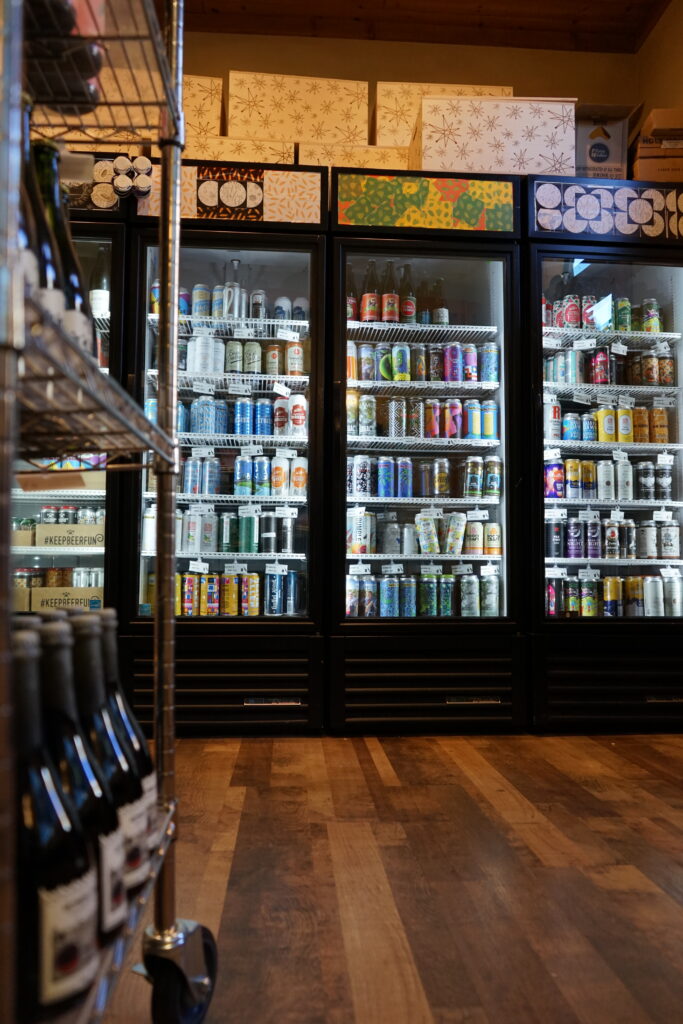
NEWS: BOTTLE SHOP BY EROSION NOW OPEN!
Perhaps you heard that we just opened up a bottle shop? Across the courtyard from our Tap House we took over a small office / retail space, and converted it to a specialty bottle shop. We currently have over 300 beers and a small selection of wines from small & often local producers. I’m the beer buyer, and I only carry beers from breweries I love, or are a benchmark for a particular beer style, or that have a particular curiosity of. If there’s anyone who is particularly happy with the selection, it is me!
I love visiting places where I can enjoy a beer / glass of wine & browse interesting beers I’m at the same time, like City Beer Store in San Francisco. In 2010 I started a beer bar & bottle shop called The Bruery Provisions based on a similar concept, which was so much fun but was so very labor intensive that I closed it down a short 3 years later! Hopefully I remember what I learned from that experience.
Many of you added bottles / cans from the Bottle Shop to your order, so the word has gotten out! As a member, you get 15% off of everything there. Try comparing your membership price with larger craft beer retailers (who tend to have the low prices), and I think you’ll be quite pleased with what you find. Plus, most of what we carry has very specialized distribution channels, so the big guys aren’t making room for them among the walls of staling IPA they stock. When you visit in person, ask to see the Member Only cabinet. We currently have Cantillon bottles and a few Baladin Xyauyu offerings that I had to beg & special order from B United. I hope to be able to offer you special beers like these once we’re able to secure enough to make everyone / most members happy. In the meantime, come visit!
THE WINES
WINE STAIN

Varietal: 100% Petite Sirah
AVA: Calistoga, Napa Valley
ABV: 17%
Amount Made: 283 cases
Patrick’s Rant: I have a complicated relationship with Petite Sirah. First off, the name. There’s nothing petite about them, it’s like calling me petite (I could lose some weight!). And Sirah, why the different spelling from your parent Syrah? Can we just call it Durif and get on with our lives? Ok, ok… we all know it wouldn’t sell as well if it were called Durif.
My second and more pressing issue– Petite Sirah has a ton of tannins which sometimes works for me, and sometimes is over the line. In the best case, the tannins are providing a rich mouthfeel and a touch of grip to balance these beastly wines. There’s not a lot of acidity, so the tannins help to balance the richness. In the less ideal case, the first few sips bring about great pleasure to be followed by a progressively intensifying mouth drying experience with every new sip. I’ll convince myself it needs to sit out for an hour to soften the tannins, but it doesn’t help. The good part about this is that it slows me down, it could take an hour before I finish my glass. The flavor can be mindblowing, but if the tannins make it unpleasant, I’m probably not coming back to that wine.
I’m thankful that in my first vintage that I was able to make the Petite Sirah that fits my tastebuds. This is a well extracted wine, we got everything we wanted from the grapes and avoided the tough parts. It has a maximum level of dark fruit & rich chocolate flavor, a faint note of week-old asphalt, a big curvy body, and a finish that begs another sip.
One knock is that 17% ABV is a lot of booze, so be careful with this one. But it doesn’t taste overly boozy, at least to my boozy tastebuds. The kind 2019 season allowed us to pick this in early October. I remember the brix readings of this vineyard when taking cluster samples were all over the place and was surprised by the high amount of sugar we got from it. Not much of the fruit had desiccated into raisins, the sugar came from plump & super ripe berries.
As with all of our wines, Wine Stain has been lightly strained and for all intents and purposes they should be considered unfiltered. This is a nice way of saying you’ll encounter sediment. Personally I’ve long associated sediment with “classy”, smaller production wines. It’s darn near impossible to find any sediment in a grocery store wine and that’s because they are filtered to death.
Production Notes: The fruit came in the first week of October and was destemmed. I recall trying to optically sort it only to find out the berry size jammed our feed table, and quickly ditching that idea. By hand we grabbed as many green jacks as possible, and put the berries into tank for a 2 day maceration at 45F. We heated the tank to 58F and added WS yeast, a fruit-forward yeast that helps promote body and is reliable, happy & alcohol tolerant. We allowed temperatures to ramp up to 95F over the next few days and used Pulsair two to three times daily to mix the tank rather than pumping over. We used filtered compressed air with Pulsair, which gives the yeast oxygen to help it perform, plus the oxygen at this early stage I believe helps to soften tannins. Once the fermentation was about 90% complete, we moved the free run wine to another tank, and pressed the skins. After doing this, a lot of the yeast is removed and fermentation goes much slower & is a little risky to have a stalled fermentation, but we wanted the wine off of the skins to reduce the grippy tannins I was looking to avoid. Thankfully the wine finished fermentation to completion. The wine was aged on three different oak staves– American oak Medium Plus toast and French oak Medium Plus toast, both from the Calistoga Nadalie cooperage. We also used Black Head Oak, which is a unique French oak toast that “bakes” the staves. As with all of our wines, we want oak to be weaved into the wine, not an element that stands out.
The Name: Pour a little on your couch and you’ll know why it’s named that.
IS IT OVER YET?
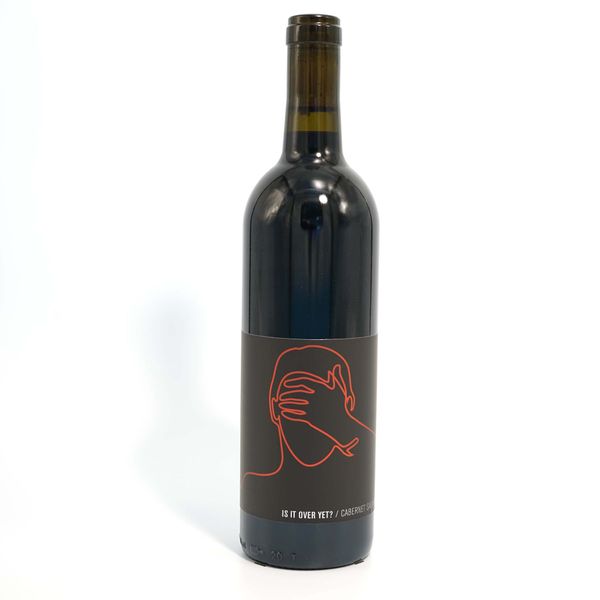
Varietals 97.8% Cabernet Sauvignon, 1.2% Cabernet Franc, 1% Merlot
AVA: Napa Valley (72.4% Mt. Veeder, 14.9% Oakville, 9.6% Yountville, 1.9% Moon Mountain, 1.2% Napa Valley)
ABV: 15.5%|
Amount Made: 121 cases
Tasting Notes
Pours thick & almost black. Violets, blueberry, molasses, black tea, espresso, dark chocolate, Australian licorice, cherry chocolate cola, candy cap mushroom, rosemary, coconut cream, burnt caramel, maduro tobacco, pomegranate syrup, crunchy licorice candy.
Food pairings
This is a meal in a glass! Seriously.
The Story
When life hands you a few hundred gallons of extra wine, you make wine! In all seriousness, we had some very delicious lots of wine that were used in single vineyard bottlings, and when we blended them together, we had something that was bigger and more decadent than any of them on their own. It’s kinda weird.
The Name
Take the name of the wine to mean what it does to you personally. All I know is we’ve all been through a lot in the past few years, right? Are things going to get to some form of “normal”, or will things just continue to get stranger? I don’t really want to answer that question, but this wine helps me ignore the question for a few blissful hours.
THE BEERS
Now that we have a Bottle Shop, we’ll include some beers we’re excited about from time to time. The Marzen style is the perfect transitional beer for the season. It’s a lager that got its name of “March”, meaning it was traditionally brewed in March, lagered in caves & brewery basements over the summer, then released in the autumn season. It borders on refreshing, while having a delicate baked bread malt balance that keeps from being too heavy.
Would you want to drink a liter of it? Maybe. Marzen used to be the standard beer style for Oktoberfests in Munich, but to fit taste preferences, have become a bit lighter and easier to drink than the Marzen. The Festbier “style” is somewhere between a Marzen and Helles. More substantial than a helles but much lighter in color and in toasted grain elements than the Marzen. The two beers included are two very different examples of the Marzen style.
HELLO FRIEND – HELLO BIER
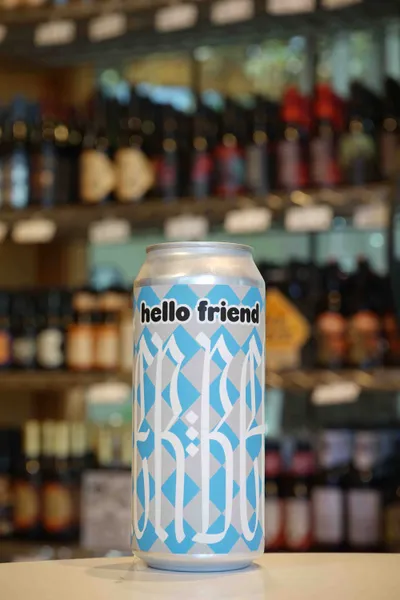
Jay Goodwin, Brad Goodwin and Alex Wallash have been good friends for over 10 years now, and they are why The Rare Barrel & its hoppy “offshoot” Hello Friend exist. Jay started his beer career at The Bruery as part of a small (less than 10 person) crew that all did just about everything. As The Bruery grew, so did Jay. He went from being a brewer to managing the wood cellar. Then one day Jay flew the coop not too far from where he grew up, and started up The Rare Barrel. If you’ve been in our Bottle Shop, you might think it was a shrine to The Rare Barrel. You’d be correct.
Hello Friend started up a little over a year ago, likely to have a polite response to the visitors to The Rare Barrel that say “ugh, I don’t like sour beer.” They’re making great lagers & IPA’s, and from the looks of it having a great time while they’re at it.
Hello Bier is their take on a Marzen, which fits the style well. It is toasty yet quite dry, making it a more refreshing & drinkable Marzen. The taste of a Marzen, the drinkability of a Festbier?
5.3% ABV
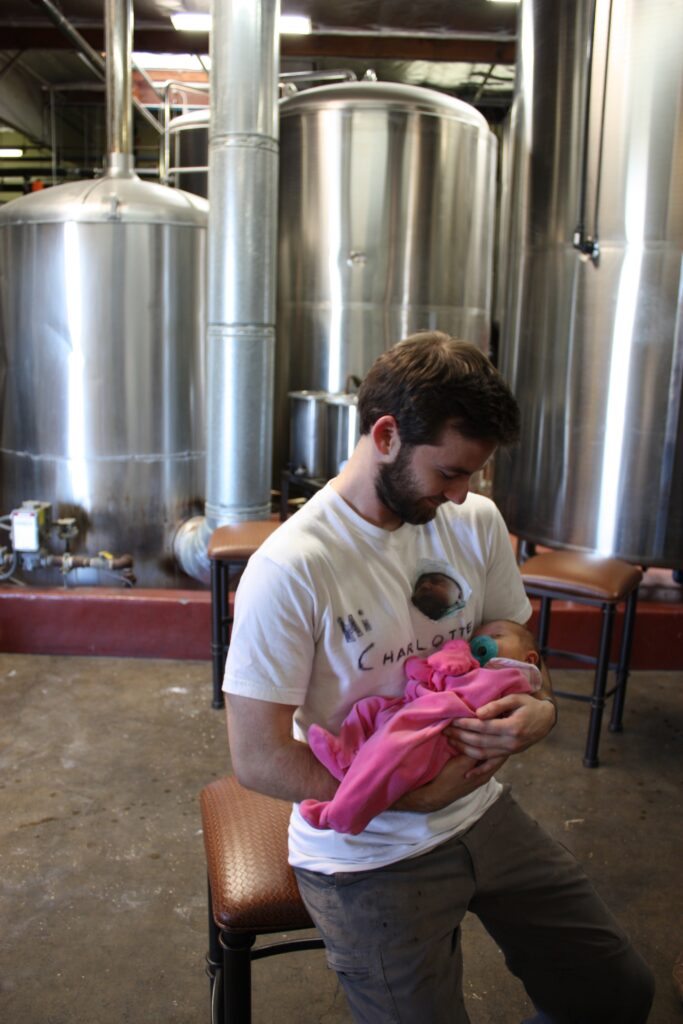
AECHT SCHLENKERLA RAUCHBIER — MARZEN

I discovered Schlenkerla early on in my homebrewing / beer geek development, and it’s one of those breweries that broadens the scope of what beer can be. It also gives a clue as to what beer tasted like hundreds of years ago.
My first taste of a Schlenkerla beer (which was the Marzen) was very similar to the first time I had a thick, fatty edge of perfectly smoked brisket where the crispy “skin” meets a sweet & soft piece of fat. First thought “Oh, wow, that’s the best thing I’ve ever tasted.” Second thought “What the f**k was that?” Third thought “Let’s do that again.”
Schlenkerla dates back to the 14th century in the city of Bamberg, Germany. This is a brewery that has kept to its roots of creating smoked beers, a very old style / method of making beer. Before we had malt kilns that were heated by a “clean” fuel source, we had malt kilns heated by wood. The wood combustion makes smoke, and the malt & the resulting beer tastes like smoke. The type of wood widely impacts the flavor, just as it is does with barbeque. Schlenkerla is one of the few breweries that kilns & smokes their own malt, and their signature wood is beechwood. Beechwood gives a potent but sweet smokiness, like you’d expect from a great piece of bacon. They also utilize other woods such as oak on occasion, but for the Marzen & most of their beers, they use beechwood.
Smoked beers tend to elicit a love / hate response. One person can also love and hate smoked beers, like me. I love Schlenkerla’s beers, and Alaskan Smoked Porter (smoked with alderwood) is a favorite of mine. I despise beers with a lot of peat smoke, which to me tastes dirty & rough. I can appreciate it in whisky, but I’d beg every brewer that feels compelled to use peat smoked malt to use it in the smallest possible percentage.
Schlenkerla Marzen is a rich, medium amber beer with a sweet smoke flavor, kind of like walking through the door of one of those run down barbeque restaurants you had to wait 2 hours in line to get into. It’s malt base is quite a bit more substantial than the Hello Bier and doesn’t finish as dry. The sturdy malt base buffers your tastebuds against the smoke, keeping everything in harmony.
5.1% ABV
BONUS BEER! EROSION – HELLA SCARY
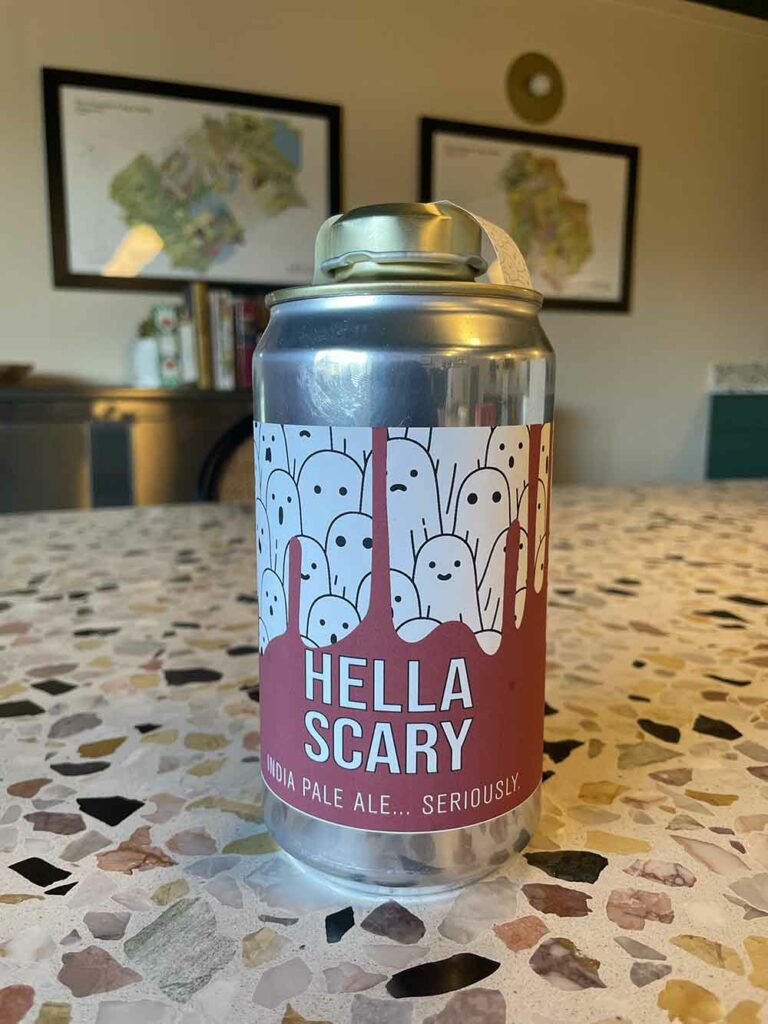
Amount Made: A tiny yield of 70 gallons. About 30 gallons was double dry hopped with Amarillo that we’ll keg off & put on tap soon.
If you know me well, you’ll know I don’t make a lot of IPA’s. Nothing against IPAs of course, they’re delicious and I drink them a lot. We should make beers that the every day craft beer drinker can understand & enjoy. We have a lot of IPAs of various sorts with our guest taps, and it’s what most of our beer customers gravitate towards. I suppose it’s time for Erosion to make them, too!
Hella Scary was brewed earlier this month and canned on 10/25, the same day we shipped it out to you!
The malt was primarily Pilsner malt from Proximity Malting from their Colorado malthouse, with a small touch of Proximity Crystal Vienna 15 and Weyermann Aciduated Malt to adjust mash pH.
It was bittered with HBC 472, a hop that I’m finding I’m not a huge fan of (this particular lot has a dill herb thing going on), so I thought I’d use a bunch of our inventory on the bittering addition. Typically what is carried through with hops that are boiled for 60 minutes+ is bitterness. Hop flavor isn’t known to be imparted because hop aromatics & flavors are volatilized during the boiling process, where hops added at the end of the boil & afterwards contribute to aroma and flavor. Well… in this case, that dill flavor still carried through. Good to learn something new!
Whirlpool hop additions of whole leaf Citra, Simcoe Cryo and Amarillo pellets were added once we recirculated wort through the heat exchanger and back into the kettle, dropping the wort temperature to 175F, which helps capture some of the flavors & aromas compared to wort at near boiling temps (211F-ish).
We used Voss Kviek yeast and fermented at 90F, allowing it to ramp up to 98F, and it fermented in about 48 hours. Such a weird yeast. Around 50% of the carbonation comes from the natural fermentation as we capped the tank towards the end of fermentation. The esters are lightly citrusy and compliment the hops, and after a brief diacetyl rest we chilled it to 32F to drop yeast.
After 10 days, the beer was transferred off of yeast to a new tank where it was dry hopped with the same varieties of hops we used in the whirlpool. The beer was warmed up to 60F for a few days, then chilled back down to 32F. Then we added some carbonation (on the lighter side to keep the mouthfeel smoother), and canned it under counter pressure.
Notes to myself that I’ll share with you for the next IPA: stop using HBC 472, and use calcium sulfate more sparingly. With the advent of hazy IPAs, I think we’re all accustomed to a softer water profile these days.
ABV: 7.5%
IBU: 50
Happy Halloween, hope you enjoy everything in good health! Thank you so much for your support of Erosion, we hope to see you soon.
Cheers,
Patrick
Owner / Maker at Erosion
